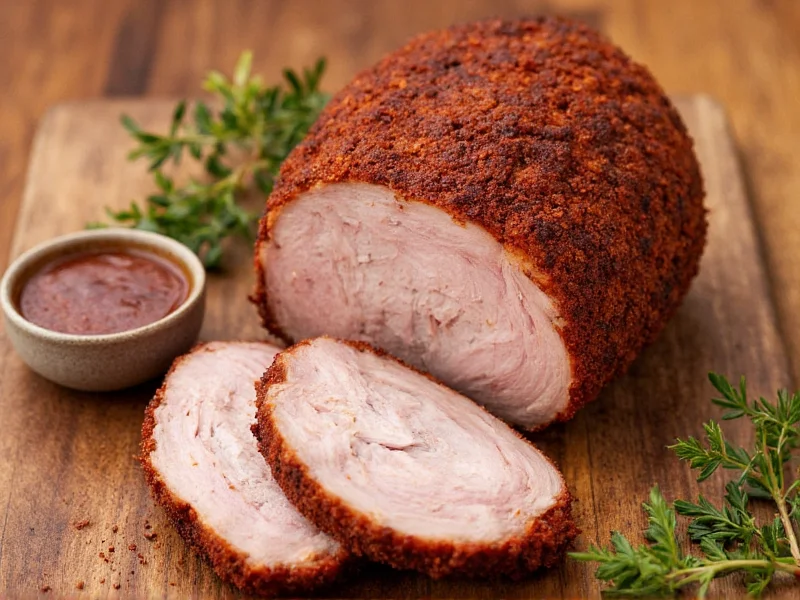Creating the perfect dry rub for pork transforms ordinary cuts into extraordinary meals. Unlike marinades that primarily affect surface flavor, dry rubs penetrate deeper while forming a delicious crust during cooking. The magic happens through osmosis—salt draws out moisture, dissolves the rub ingredients, then pulls them back into the meat. This process works best when you understand how different pork cuts interact with seasoning.
Why Pork Responds Exceptionally Well to Dry Rubs
Pork's mild flavor profile and moderate fat content make it an ideal canvas for dry rubs. The fat marbling carries fat-soluble flavor compounds from spices like paprika and cumin, while the meat's protein structure readily absorbs salt and sugar. Unlike beef, pork benefits from slightly sweeter rub profiles that complement its natural sugars without overwhelming its delicate taste.
Core Components of an Effective Pork Dry Rub
Every successful dry rub contains these essential elements in proper balance:
Salt: The Flavor Conductor
Salt isn't just for seasoning—it's crucial for flavor development and texture improvement. Use 1 tablespoon of kosher salt per pound of pork as your baseline. Fine sea salt works better for quick applications, while coarse salts like kosher provide slower dissolution for long smokes. Avoid iodized table salt, which can impart metallic notes.
Sugar: The Maillard Reaction Catalyst
Sugar creates that irresistible caramelized crust through the Maillard reaction. Brown sugar adds molasses notes perfect for pulled pork, while white sugar works better for quicker-cooking chops. For best dry rub for pork shoulder, use a 2:1 ratio of brown to white sugar. Those seeking a pork dry rub without sugar can substitute powdered mushroom for umami depth.
Base Spices: Flavor Foundation
Paprika forms the backbone of most pork rubs, providing color and earthy sweetness. Smoked paprika adds complexity for dry rub for smoked pork, while sweet Hungarian paprika works better for grilled applications. Garlic and onion powders deliver consistent flavor without burning that fresh counterparts would.
Supporting Cast: Personality Boosters
Cayenne brings heat that cuts through pork's richness, while black pepper adds aromatic complexity. Mustard powder enhances browning and emulsifies fats. For dry rub for pork loin, consider adding dried thyme or rosemary for herbal notes that complement leaner cuts.
Optimal Dry Rub Formulas by Pork Cut
Different cuts require tailored approaches. Here's how to adjust your homemade pork dry rub recipe for specific applications:
| Pork Cut | Salt (tbsp) | Sugar (tbsp) | Core Spices | Special Additions | Application Time |
|---|---|---|---|---|---|
| Pork Shoulder | 4 | 2 | 2 paprika, 1 garlic, 1 onion | 1 tbsp mustard powder | 12-24 hours |
| Pork Ribs | 3 | 3 | 1.5 paprika, 1 garlic, 1 onion | 0.5 cayenne, 1 coffee | 6-12 hours |
| Pork Loin | 3.5 | 1.5 | 1 paprika, 1 garlic, 1 onion | 1 thyme, 0.5 sage | 2-4 hours |
| Pork Chops | 3 | 1 | 1 paprika, 0.5 garlic, 0.5 onion | 0.5 coriander, lemon zest | 1-2 hours |
Professional Application Techniques
How you apply your dry rub for pork rib matters as much as the ingredients. Follow these steps for optimal results:
- Dry the surface: Pat pork completely dry with paper towels—moisture prevents proper adhesion
- Oil lightly: A thin coat of neutral oil helps the rub adhere without creating a paste
- Season generously: Apply rub using a pinching motion to create an even layer, not clumps
- Refrigerate uncovered: Allows the surface to dry slightly, enhancing crust formation
- Bring to temperature: Remove from fridge 1 hour before cooking for even heat penetration
Avoiding Common Dry Rub Mistakes
Even with the best dry rub for pork, improper technique can ruin results:
- Over-rubbing: Excessive rub creates a bitter, chemical-like crust. Aim for visible meat between particles
- Ignoring timing: Applying rubs immediately before cooking only seasons the surface. Minimum 1 hour, ideally 12+ for large cuts
- Using old spices: Ground spices lose potency after 6 months. Freshly grind whole spices when possible
- Sugar burning: For high-heat grilling, reduce sugar content or wrap pork in foil during initial cooking phase
Customizing Your Rub for Dietary Needs
Adapt your dry rub ingredients for pulled pork to accommodate special diets without sacrificing flavor:
- Sugar-free option: Replace sugar with powdered porcini mushrooms (2:1 ratio) for umami depth
- Low-sodium version: Use celery salt and increase garlic/onion powder to maintain flavor impact
- Smoke-free alternative: Add a pinch of liquid smoke to dry rub for indoor cooking
- Allergy-friendly: Check spice blends for hidden allergens; make your own from single-ingredient spices
Storage and Preparation Tips
Maximize your rub's effectiveness with these professional practices:
- Mix dry rubs at least 24 hours before use to allow flavors to meld
- Store in airtight containers away from light and heat (not above the stove)
- Label containers with dates—most rubs stay potent for 3-6 months
- For dry rub for grilled pork chops, add citrus zest just before application for brightness
- Double your batch and store extra—it makes excellent seasoning for roasted vegetables
Final Considerations for Perfect Pork Every Time
The best dry rub for pork balances science and personal preference. While ratios provide a starting point, adjust based on your cooking method and equipment. A rub perfect for your pellet smoker might need sugar reduction for direct charcoal grilling. Always taste your rub mixture (sparingly—it's concentrated!) before applying. Remember that the quality of your pork matters as much as the rub—choose well-marbled cuts from reputable sources for optimal results. With proper technique and attention to detail, you'll consistently achieve pork with deep, complex flavors and that coveted bark texture professionals prize.











 浙公网安备
33010002000092号
浙公网安备
33010002000092号 浙B2-20120091-4
浙B2-20120091-4